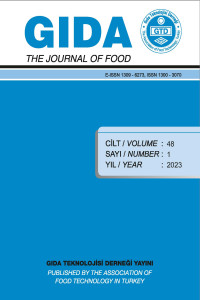KAFEİN MOLEKÜLÜNÜN MÜSİN PROTEİNİ İLE OLAN ETKİLEŞİMİNİN FLORESAN SPEKTROSKOPİ TEKNİĞİ İLE ARAŞTIRILMASI
Öz
Anahtar Kelimeler
kafein müsin floresan söndürme pH Stern-Volmer caffeine mucin fluorescence quenching
Destekleyen Kurum
TÜBİTAK 2209/A Üniversite Öğrencileri Araştırma Projeleri Destek Programı
Proje Numarası
14033406326
Teşekkür
Bu araştırmayı finanse ettiklerinden dolayı TÜBİTAK 2209/A Üniversite Öğrencileri Araştırma Projeleri Destek Programı’na teşekkür ederiz.
Kaynakça
- Alsabri, S. G., Mari, W. O., Younes, S., Elsadawi, M. A., Oroszi, T. L. (2018). Kinetic and dynamic description of caffeine. Journal of Caffeine and Adenosine Research, 8(1), 3-9.
- Bansil, R., Turner, B. S. (2006). Mucin structure, aggregation, physiological functions and biomedical applications. Current opinion in colloid & interface science, 11(2-3), 164-170.
- Bian, W., Wei, Y. L., Wang, Y. P., Dong, C. (2006). Study on interaction of caffeine and theophylline with bovine serum albumins. Guang pu xue yu Guang pu fen xi= Guang pu, 26(3), 505-508.
- Brandão, E., Silva, M. S., García-Estévez, I., Mateus, N., de Freitas, V., Soares, S. (2017). Molecular study of mucin-procyanidin interaction by fluorescence quenching and Saturation Transfer Difference (STD)-NMR. Food chemistry, 228, 427-434.
- Çelebioğlu, H. Y., Gudjónsdóttir, M., Meier, S., Duus, J. Ø., Lee, S., Chronakis, I. S. (2015). Spectroscopic studies of the interactions between β-lactoglobulin and bovine submaxillary mucin. Food Hydrocolloids, 50, 203-210.
- Çelebioğlu, H. Y., Lee, S., Chronakis, I. S. (2020). Interactions of salivary mucins and saliva with food proteins: A review. Critical reviews in food science and nutrition, 60(1), 64-83.
- Giraddi, T. P., Kadadevarmath, J. S., Malimath, G. H., Chikkur, G. C. (1996). Effect of solvent on the fluorescence quenching of organic liquid scintillators by aniline and carbon tetrachloride. Applied radiation and isotopes, 47(4), 461-466.
- Grosso, G., Godos, J., Galvano, F., Giovannucci, E. L. (2017). Coffee, caffeine, and health outcomes: An umbrella. Annual Review of Nutrition, 37, 131-156.
- Hamada, E., Nakajima, T., Hata, Y., Hazama, H., Iwasawa, K., Takahashi, M., ... Omata, M. (1997). Effect of caffeine on mucus secretion and agonist-dependent Ca2+ mobilization in human gastric mucus secreting cells. Biochimica et Biophysica Acta (BBA)-Molecular Cell Research, 1356(2), 198-206.
- Islam, M. M., Sonu, V. K., Gashnga, P. M., Moyon, N. S., Mitra, S. (2016). Caffeine and sulfadiazine interact differently with human serum albumin: A combined fluorescence and molecular docking study. Spectrochimica Acta Part A: Molecular and Biomolecular Spectroscopy, 152, 23-33.
- Lakowicz, J. R. (1999). Instrumentation for fluorescence spectroscopy. In Principles of fluorescence spectroscopy (pp. 25-61). Springer, Boston, MA.
- Lakowicz, J.R. (2006). Principles of Fluorescence Spectroscopy; 3rd ed.; Springer: Baltimore, Maryland; ISBN 978-0-387-46312-4.
- Lisko, J. G., Lee, G. E., Kimbrell, J. B., Rybak, M. E., Valentin-Blasini, L., Watson, C. H. (2017). Caffeine concentrations in coffee, tea, chocolate, and energy drink flavored e-liquids. Nicotine & Tobacco Research, 19(4), 484-492.
- Madsen, J. B., Sotres, J., Pakkanen, K. I., Efler, P., Svensson, B., Abou Hachem, M., ... Lee, S. (2016). Structural and mechanical properties of thin films of bovine submaxillary mucin versus porcine gastric mucin on a hydrophobic surface in aqueous solutions. Langmuir, 32(38), 9687-9696.
- Mensi, A., Choiset, Y., Rabesona, H., Haertlé, T., Borel, P., Chobert, J. M. (2013). Interactions of β-lactoglobulin variants A and B with vitamin A. Competitive binding of retinoids and carotenoids. Journal of agricultural and food chemistry, 61(17), 4114-4119.
- Moco, S., Martin, F. P. J., Rezzi, S. (2012). Metabolomics view on gut microbiome modulation by polyphenol-rich foods. Journal of proteome research, 11(10), 4781-4790.
- Pan, M. H., Tung, Y. C., Yang, G., Li, S., Ho, C. T. (2016). Molecular mechanisms of the anti-obesity effect of bioactive compounds in tea and coffee. Food & function, 7(11), 4481-4491.
- Papadopoulou, A., Green, R. J., Frazier, R. A. (2005). Interaction of flavonoids with bovine serum albumin: a fluorescence quenching study. Journal of agricultural and food chemistry, 53(1), 158-163.
- Svensson, O., Arnebrant, T. (2010). Mucin layers and multilayers—Physicochemical properties and applications. Current Opinion in Colloid & Interface Science, 15(6), 395-405.
- Wang, Y. Q., Zhang, H. M., Zhou, Q. H. (2009). Studies on the interaction of caffeine with bovine hemoglobin. European journal of medicinal chemistry, 44(5), 2100-2105.
- Yılmaz, H., Lee, S., Chronakis, I. S. (2021). Interactions of β-Lactoglobulin with Bovine Submaxillary Mucin vs. Porcine Gastric Mucin: The Role of Hydrophobic and Hydrophilic Residues as Studied by Fluorescence Spectroscopy. Molecules, 26(22), 6799.
INVESTIGATION OF THE INTERACTION BETWEEN CAFFEINE MOLECULE AND MUSIN PROTEIN BY FLUORESCENCE SPECTROSCOPY TECHNIQUE
Öz
Anahtar Kelimeler
Proje Numarası
14033406326
Kaynakça
- Alsabri, S. G., Mari, W. O., Younes, S., Elsadawi, M. A., Oroszi, T. L. (2018). Kinetic and dynamic description of caffeine. Journal of Caffeine and Adenosine Research, 8(1), 3-9.
- Bansil, R., Turner, B. S. (2006). Mucin structure, aggregation, physiological functions and biomedical applications. Current opinion in colloid & interface science, 11(2-3), 164-170.
- Bian, W., Wei, Y. L., Wang, Y. P., Dong, C. (2006). Study on interaction of caffeine and theophylline with bovine serum albumins. Guang pu xue yu Guang pu fen xi= Guang pu, 26(3), 505-508.
- Brandão, E., Silva, M. S., García-Estévez, I., Mateus, N., de Freitas, V., Soares, S. (2017). Molecular study of mucin-procyanidin interaction by fluorescence quenching and Saturation Transfer Difference (STD)-NMR. Food chemistry, 228, 427-434.
- Çelebioğlu, H. Y., Gudjónsdóttir, M., Meier, S., Duus, J. Ø., Lee, S., Chronakis, I. S. (2015). Spectroscopic studies of the interactions between β-lactoglobulin and bovine submaxillary mucin. Food Hydrocolloids, 50, 203-210.
- Çelebioğlu, H. Y., Lee, S., Chronakis, I. S. (2020). Interactions of salivary mucins and saliva with food proteins: A review. Critical reviews in food science and nutrition, 60(1), 64-83.
- Giraddi, T. P., Kadadevarmath, J. S., Malimath, G. H., Chikkur, G. C. (1996). Effect of solvent on the fluorescence quenching of organic liquid scintillators by aniline and carbon tetrachloride. Applied radiation and isotopes, 47(4), 461-466.
- Grosso, G., Godos, J., Galvano, F., Giovannucci, E. L. (2017). Coffee, caffeine, and health outcomes: An umbrella. Annual Review of Nutrition, 37, 131-156.
- Hamada, E., Nakajima, T., Hata, Y., Hazama, H., Iwasawa, K., Takahashi, M., ... Omata, M. (1997). Effect of caffeine on mucus secretion and agonist-dependent Ca2+ mobilization in human gastric mucus secreting cells. Biochimica et Biophysica Acta (BBA)-Molecular Cell Research, 1356(2), 198-206.
- Islam, M. M., Sonu, V. K., Gashnga, P. M., Moyon, N. S., Mitra, S. (2016). Caffeine and sulfadiazine interact differently with human serum albumin: A combined fluorescence and molecular docking study. Spectrochimica Acta Part A: Molecular and Biomolecular Spectroscopy, 152, 23-33.
- Lakowicz, J. R. (1999). Instrumentation for fluorescence spectroscopy. In Principles of fluorescence spectroscopy (pp. 25-61). Springer, Boston, MA.
- Lakowicz, J.R. (2006). Principles of Fluorescence Spectroscopy; 3rd ed.; Springer: Baltimore, Maryland; ISBN 978-0-387-46312-4.
- Lisko, J. G., Lee, G. E., Kimbrell, J. B., Rybak, M. E., Valentin-Blasini, L., Watson, C. H. (2017). Caffeine concentrations in coffee, tea, chocolate, and energy drink flavored e-liquids. Nicotine & Tobacco Research, 19(4), 484-492.
- Madsen, J. B., Sotres, J., Pakkanen, K. I., Efler, P., Svensson, B., Abou Hachem, M., ... Lee, S. (2016). Structural and mechanical properties of thin films of bovine submaxillary mucin versus porcine gastric mucin on a hydrophobic surface in aqueous solutions. Langmuir, 32(38), 9687-9696.
- Mensi, A., Choiset, Y., Rabesona, H., Haertlé, T., Borel, P., Chobert, J. M. (2013). Interactions of β-lactoglobulin variants A and B with vitamin A. Competitive binding of retinoids and carotenoids. Journal of agricultural and food chemistry, 61(17), 4114-4119.
- Moco, S., Martin, F. P. J., Rezzi, S. (2012). Metabolomics view on gut microbiome modulation by polyphenol-rich foods. Journal of proteome research, 11(10), 4781-4790.
- Pan, M. H., Tung, Y. C., Yang, G., Li, S., Ho, C. T. (2016). Molecular mechanisms of the anti-obesity effect of bioactive compounds in tea and coffee. Food & function, 7(11), 4481-4491.
- Papadopoulou, A., Green, R. J., Frazier, R. A. (2005). Interaction of flavonoids with bovine serum albumin: a fluorescence quenching study. Journal of agricultural and food chemistry, 53(1), 158-163.
- Svensson, O., Arnebrant, T. (2010). Mucin layers and multilayers—Physicochemical properties and applications. Current Opinion in Colloid & Interface Science, 15(6), 395-405.
- Wang, Y. Q., Zhang, H. M., Zhou, Q. H. (2009). Studies on the interaction of caffeine with bovine hemoglobin. European journal of medicinal chemistry, 44(5), 2100-2105.
- Yılmaz, H., Lee, S., Chronakis, I. S. (2021). Interactions of β-Lactoglobulin with Bovine Submaxillary Mucin vs. Porcine Gastric Mucin: The Role of Hydrophobic and Hydrophilic Residues as Studied by Fluorescence Spectroscopy. Molecules, 26(22), 6799.
Ayrıntılar
| Birincil Dil | Türkçe |
|---|---|
| Konular | Gıda Mühendisliği |
| Bölüm | Makaleler |
| Yazarlar | |
| Proje Numarası | 14033406326 |
| Erken Görünüm Tarihi | 20 Aralık 2022 |
| Yayımlanma Tarihi | 15 Şubat 2023 |
| Yayımlandığı Sayı | Yıl 2023 Cilt: 48 Sayı: 1 |



